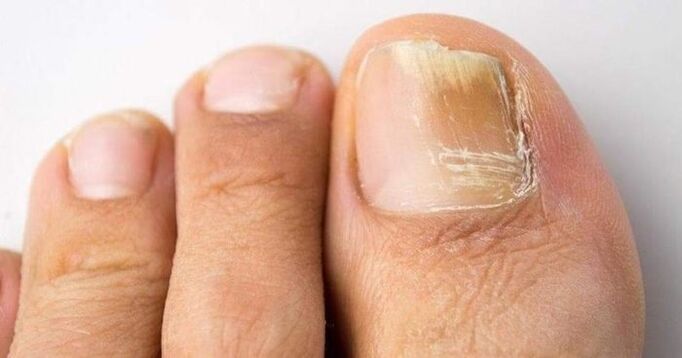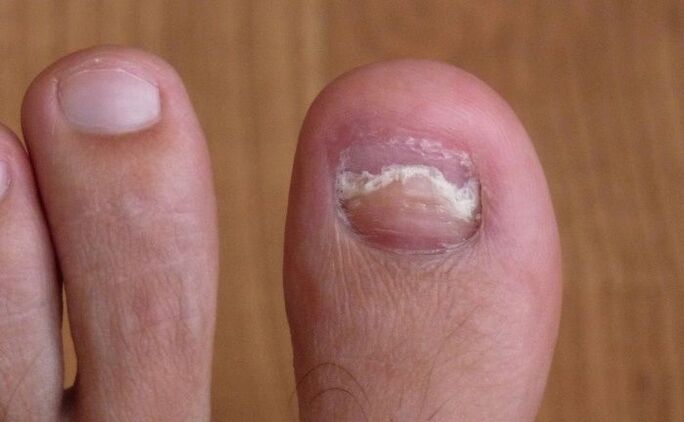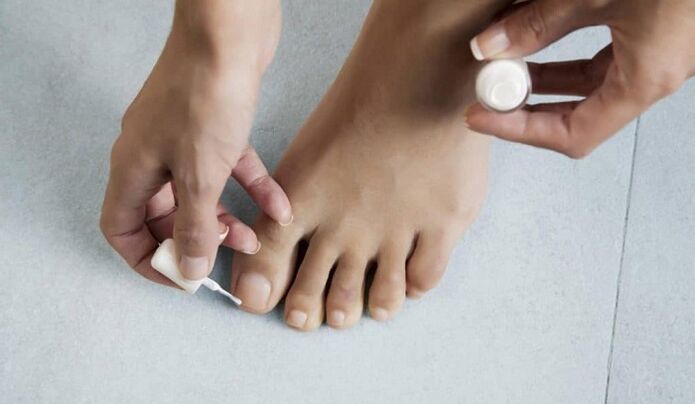Fungal diseases can affect various tissues of the body, even internal organs. If the disease affects the nails, it is called onychomycosis. Its appearance is caused by fungal microorganisms.
They are divided into different genera: candida, fungal infections, dermatophytes. Parasites literally eat the nail plate, causing initial destruction. Mycosis itself is not gone. This is possible only with the work of the strongest immune system and the first stage of the disease, when the symptoms are not visible. If signs of the disease appear, you can be sure that they will not go anywhere without therapy.

Reasons for appearance
Fungal microorganisms belong to the class of irritants. They are very persistent. They quickly penetrate the tissue, adapting to a variety of conditions. This is due to the complexity of the treatment of this disease. If you use the same medicine for a long time, the parasite may stop responding to it.
The only reason for the appearance of this disease is the entry of fungus on the nail plate. However, there are factors that support early identification in and reproduction. Microorganisms are more likely to penetrate tissues if they have corn. Even dry skin can cause microcracks, through which fungus can easily penetrate. Microorganisms "like" wet conditions, and therefore spread actively in people who prefer tight shoes made of bad materials that do not allow air to enter.
Often, toenail fungus appears with a background of various pathologies:
- Endocrine diseases;
- Psoriasis;
- Varicose veins;
- Vascular disease;
- HIV and AIDS;
- Problems with metabolic processes;
- Eczema;
- Dermatitis;
- The infectious process of the skin.
Fungal microorganisms can enter the dish in the following ways:
- Contact with the carrier of the infection;
- Visit public baths, saunas, showers;
- Wearing other people's slippers (for example, at a party);
- Living with mycosis;
- Try on shoes;
- Using a pedicure tool that has not been disinfected;
- Visiting a beauty house.
Factors that cause the appearance of mycosis are also:
- Lack of adequate personal hygiene;
- Preference for synthetic items;
- Wear tight -fitting shoes that don’t allow the skin to "breathe";
- Excessive obesity;
- Frequent alcohol intake;
- Old age.
The disease will have a more pronounced manifestation if a person suffers from circulatory disorders in the foot area. Also, changes in acid balance observed while taking antibiotics can cause pathological processes.
The stage of the disease
The surface under the nail is very good for the growth of fungal microorganisms. It contains many nutrients that parasites feed on. Gradually, due to the effects of bacteria, destruction of the nail plate occurs. Cavities begin to form, where the fungal mycelium multiplies. There are the following stages of the disease:
- The beginning.Refers to the type of normotrophic damage. The main damage affects the middle or edges of the plate. Patches and streaks appear, which gradually begin to grow;
- On average.It is a hypertrophic change. This stage is characterized by thickening of the nail, changes in its structure, the direction of growth. The pathological process gradually spreads throughout the plate;
- Stages of dystrophy.For the processes listed, inflammation in the nail fold area is added. Removal of pus is possible. The lesion reaches the adjacent skin. Additional bacterial infections accelerate nail destruction. It begins to crumble, it can peel off from the base of the nail.
At first, the symptoms are insignificant, and therefore people often take the disease lightly. However, it is growing rapidly. Soon, the raised spots will start to grow. The disease can spread from the thumb to others.
If only small pictures are affected, it is usually mild to moderate. Therapy should be carried out immediately.

Symptoms
Symptoms vary greatly depending on the stage of the disease. At first, the signs of a threat are almost impossible to notice. With the development of this disease, the following symptoms can be observed:
- Slight itching;
- Redness in the thumb area;
- Burning sensation.
But the pathological process does not stop. Its growth can be assessed based on the following characteristics:
- Brittle plate, loss of natural luster;
- Acquisition of yellow, blue or green color (depending on the type of fungal microorganisms affecting the nail);
- Spoken patches and paths appear;
- The nail grows at an angle into the roller, which is evidence of the deformation of its growth.
At a later stage, the following symptoms may be:
- Pain syndrome when walking;
- Appearance of swollen fingers, marked redness;
- Discharge of pus from the bottom edge.
The signs of large nail fungus can vary depending on the type of fungus that is causing the infection. For example, if this is a fungal fungus, the disease will be very noticeable. Nails can literally be black. There is swelling, the appearance of silvery scales, yellow edges. The plate began to move away from the bed, which caused severe discomfort. However, in 95% of cases, the cause of the infection is a dermatophyte. They are characterized by a relatively mild disease.
The disease affects not only the nails, but also the whole body. This is due to the fact that toxins enter the lymphatic vessels. This provoked the following changes:
- Allergic reactions, the appearance of skin rashes;
- Gastrointestinal problems;
- Signs of intoxication.
If nothing is done with the advanced stage of mycosis, the lesion can spread to internal organs. This is very dangerous.
How is treatment carried out?
How to Cure Nail Fungus? Pathogenic microorganisms are distinguished by enviable resistance to various influences. They quickly take root inwards and begin to actively reproduce. Therefore, it is desirable to carry out antifungal therapy completely. It includes:
- Using local funds. It can be ointments, drops, medicinal varnishes, solutions. They are needed to beat the disease at a superficial level. Among the local remedies are varnishes, serums;
- Systemic medicine. They are used for significant wounds on the nail plate. Tablets are used daily. Effective pulse therapy. It consists of taking short -term medication over a long period of time. Then the course is repeated. It should be noted that the pill should not be taken in all circumstances. Do not use it in the early stages of the disease. These funds are quite strong, and therefore have contraindications: pregnancy, children, renal failure, intolerance to its components.
The disease is often accompanied by bacterial complications. You can also be safe from them. Antifungal varnishes are ideal for this purpose. It produces a film on the surface of the plate where bacteria do not penetrate.
In addition, it is necessary to stimulate the body's defense objectives, which will be directed to fight infection. For this, vitamin complexes, immunomodulatory drugs are used.
A large number of drugs have cumulative effects. It is not enough to take it once and forget about therapy. A complete course is required.
It will not end even if all symptoms have disappeared. The active ingredient accumulates in the device and continues to act even after the medication is over.
Another additional procedure is nail removal. Associated with strong pathological processes. Removal can be done using products containing special urea. If the plate is stiff, several procedures will be required to release it completely. Removal should not be feared, as it is not painful. After removal, you need to treat the surface with antiseptic. Removal is easy because, after that, local remedies can be applied directly to the base of the nail. This greatly increases their efficiency.

Traditional methods
Folk remedies cannot replace medicines. But they are ideal for extra help. The following components help from the fungus:
- Iodine.The affected area should be lubricated with iodine twice a day. If there is a burning sensation, you need to remove all excess and reduce the dose;
- Lemon.A slice of lemon is applied to the affected area, after which it is repaired with a bandage. Cellophane is placed on top;
- Hydrogen peroxide.A layer of cotton is moistened with hydrogen peroxide, after which it is glued to the nail for 30 minutes. Softened areas can be removed.
After all these procedures, treatment with topical antimicrobial agents is highly desirable.
Preventive measures
It is important to observe preventive measures not only for people who do not want to be infected with mycosis. This is the basis for people who have just got rid of the disease. Prevention consists of the following rules:
- Adherence to personal hygiene;
- Bathe your feet every day;
- Foot lubrication with moisturizer, pedicure;
- Use of personal slippers;
- Treat nails with prophylactic agents before bathing, showering. You can replace special products with lemon juice.
Preventive measures for people who have recently had mycosis are more stringent:
- Use once a week a local remedy for fungus;
- Regular use of hot foot baths with the addition of sea salt;
- Shoe treatment with antifungal compounds;
- Boiling stockings, in which there is complete destruction of microorganisms;
- You must continue to take vitamins;
- The surface of the bath is disinfected. It is best to treat all other surfaces in the house as well.
Prevention with a high degree of probability protects against mycosis. You just have to monitor the condition of your feet. If the symptoms do not clearly reappear, you should immediately see a doctor. Self -medication is not recommended, as mycosis is easily confused with other problems. In this case, the wrong treatment will be chosen, and the disease will continue. All this is fraught with big problems in the future. The receipt of systemic funds, without fail, is carried out under the supervision of a physician.

























